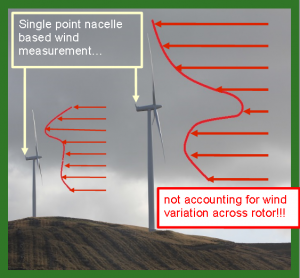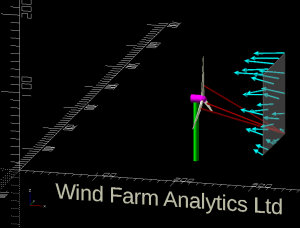There are very many advantages and benefits offered by convergent beam LIDAR:
- direct measurement system applying fundamental physics and eliminating assumptions and ambiguities
- look ahead warning of incoming damaging wind signatures
- thereby allowing beneficial warnings and alarms
- enabling protective actions to reduce fatigue loads and extreme loads
- reducing damage throughout the turbine lifetime – in blades, drive train, tower, onshore foundation, offshore transition piece and substructure
- lengthening the lifetime of wind turbine components
- reducing cost of operation and maintenance during the entire asset lifetime – less downtime, less repair costs, less secondary damage costs, less component costs, less mobilisation costs of personnel and equipment such as offshore vessels / cranes
- enabling larger rotors
- allows improved yaw control by accounting for wind direction across the entire rotor, not just wind direction as measured at the nacelle
- thereby harvesting more wind power for increased energy yield and getting more out of the investment asset
- allows direct upwind measurement of actual wind speed and rotor averaged / rotor equivalent wind speed so that wind turbine owners can obtain direct power curve measurement without need for meteorological mast or dependence upon imperfect nacelle instruments
- look ahead wind forecast can allow improved grid management – for instance a large offshore wind farm may be about to suffer storm shutdown and the grid infrastructure management can have one or two minutes warning in order to spin up hydro/ wind-pumped hydro energy storage to take over the loss of load using pure renewable energy (low carbon energy security)
- allows lifetime logging of historic wind experience
- for estimating remaining lifetime
- offering big data fleet wide and turbine specific analysis by both human and artificial intelligence
- therefore lowering the cost of energy via multiple value mechanisms
We have all seen the movement of the leaves and branches of a large tree in the wind and the variation in wind is clearly visible across the tree. But large wind turbine rotors are ten times bigger than a large tree so think of the huge variation across a large rotor! By use of the scanning converging beam geometry we can eliminate ambiguity and spatial/volumetric sampling error of diverging beam LIDAR whether using diverging fixed beams or conical scan, both of which methods combine LIDAR measurements from points in space which are very far apart (eg 100 metres apart) and therefore ignore or fail to account for spatial variation in the wind field. By converging three LIDAR beams at a chosen measurement location we can
- achieve local three-dimensional wind vector measurement, without making false assumption of purely horizontal wind flow or uniform flow across large rotors
- respecting mathematical fact that accurate measurement of a 3-dimensional velocity requires three Doppler beams at the measurement location
- this design has uninterrupted beams compared with LIDARs located behind rotor blades which obstruction reduces data availability, or the nacelle itself which reduces the field of view for nacelle based LIDARs
- allowing accurate localised turbulence measurement without spatial averaging errors inherent to diverging beam LIDAR
- produce three dimensional wind field mapping of numerous attributes and their variation across the entire rotor area including wind direction, wind velocity, non-horizontal inflow angle, yaw error, local turbulence intensity, vertical/horizontal shear, vertical/horizontal veer
- laser-based LIDAR is a non-invasive measurement method which does not significantly alter the wind system which it measures
- offering volumetric measurement maps covering long and short ranges and wide angular feld of view
- a programmable system which can be standardised or tailored to specific functions and research
- perhaps giving a warning of damaging wind gusts at 200 metres and raising confirmed alarms if this signature persists to 50 metres or another range chosen according to wind speed and time taken for protective action to be executed
In the long run this technology will offer numerous further benefits to all participants in the wind industry as we are able to learn much more about what kind of wind signatures are most damaging to our turbines:
- enabling cheaper wind turbine production without the need for unnecessarily large engineering safety factors to handle wind loads which can be eliminated
- allowing intelligent scheduling of maintenance tuned per turbine – assisting condition based maintenance and avoiding unnecessary turbine visits and mobilisation of personnel/equipment
- more appropriate warranty specifications
- better insurance policies
- advanced wind turbine classifications and better choice of turbine per site
- evolving wind turbine engineering standards
- better micrositing during planning
- therefore reducing uncertainty for investors and lowering the cost of clean energy
- offers economic opportunity and high value manufacturing opportunity towards export into wind turbine production lines as well as a retrofit product
- this system can be trained and tested to recognise damaging wind signatures with high success rate whilst obtaining a low false alarm rate and consider interfacing with control system only once proven to be sufficiently beneficial
- continuously learning system allows for successive software release versions of ever improving parameter sets
Wind turbines work well but we can make them work even better! Current day LIDAR works well but we can make it even better! Please get in touch if you wish to discuss…


